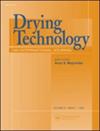Study on the solid-liquid separation mechanism of the inverting filter centrifuge’s dewatering process
IF 2.7
3区 工程技术
Q3 ENGINEERING, CHEMICAL
引用次数: 1
Abstract
Abstract Centrifugal dewatering is a common process used for solid-liquid separation in chemical industry. This process involves the intricate interaction between particles and liquid under centrifugal pressure. Accurate modeling and simulation of the kinetic process are key to optimizing the dewatering parameters. However, the feeding stage is often disregarded in most of the simulation studies, leading to obvious differences from the actual conditions in the dewatering behavior and initial solid concentration. In this study, a 1D-axisymmetric model is established to simulate the feeding and pre-dewatering stages of an inverting filter centrifuge. The simulation results at different rotating speeds agree with the experimental observations and show a significant difference compared to the model that ignores the feeding stage. Both phenomena demonstrate the method in this study is accurate and reliable. Furthermore, the effects of feeding parameters are investigated using the Sobol global sensitivity analysis method. This study provides crucial assistance for the parameters’ optimization and prediction of centrifugal dewatering.反滤式离心机脱水过程固液分离机理研究
本文章由计算机程序翻译,如有差异,请以英文原文为准。
求助全文
约1分钟内获得全文
求助全文
来源期刊

Drying Technology
工程技术-工程:化工
CiteScore
7.40
自引率
15.20%
发文量
133
审稿时长
2 months
期刊介绍:
Drying Technology explores the science and technology, and the engineering aspects of drying, dewatering, and related topics.
Articles in this multi-disciplinary journal cover the following themes:
-Fundamental and applied aspects of dryers in diverse industrial sectors-
Mathematical modeling of drying and dryers-
Computer modeling of transport processes in multi-phase systems-
Material science aspects of drying-
Transport phenomena in porous media-
Design, scale-up, control and off-design analysis of dryers-
Energy, environmental, safety and techno-economic aspects-
Quality parameters in drying operations-
Pre- and post-drying operations-
Novel drying technologies.
This peer-reviewed journal provides an archival reference for scientists, engineers, and technologists in all industrial sectors and academia concerned with any aspect of thermal or nonthermal dehydration and allied operations.
 求助内容:
求助内容: 应助结果提醒方式:
应助结果提醒方式:


